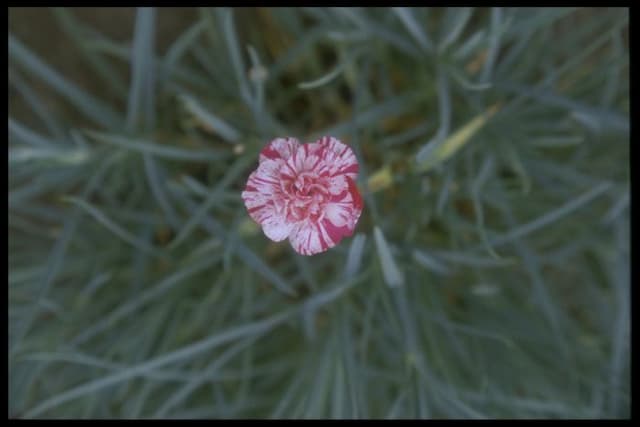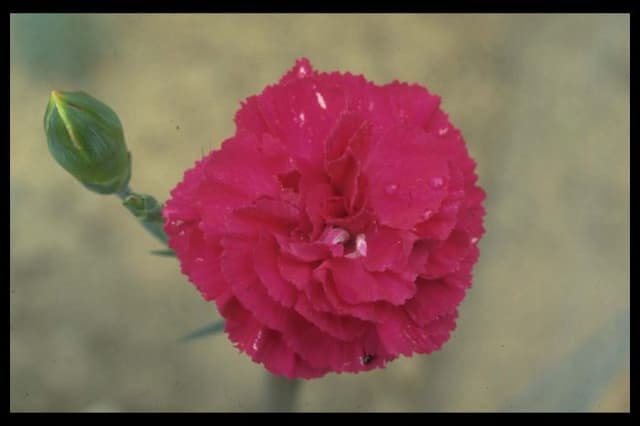Sweet William Dianthus Viana = 'Kovian' (PBR) (pf)
![perpetual-flowering carnation [Viana]](/_next/image?url=https%3A%2F%2Fplants-admin.emdemapps.com%2Fimages%2Fplants%2F%2Fimages%2F604b63fe46ad4.png&w=3840&q=75)
ABOUT
The Dianthus Viana, also known by its common name, is a captivating plant that boasts a beautiful array of flowers. These blossoms are distinct in their frilly edges, often appearing somewhat ruffled, which gives them a charmingly textured look. The petals range in color, but they frequently display shades of pink, red, or purple, and they sometimes feature unique patterning such as streaks or borders in contrasting hues. These flowers emit a delightful fragrance which can be quite noticeable when in bloom, making them a favorite among gardeners who appreciate scented plants. The foliage of the Dianthus Viana forms a dense clump at the base of the stems. The leaves exhibit a slender, elongated shape and often carry a bluish-green to gray-green color, providing a pleasing backdrop to the vivid flowers. The overall appearance of this plant is one that exudes both neatness and vibrancy, making it an attractive option for garden borders, rock gardens, or as a standalone feature in a plant collection. The allure of the Dianthus Viana is not solely in individual blooms; the plant forms a mass of color when several are planted together, creating a tapestry of floral beauty.
About this plant
 Names
NamesSynonyms
Pink Kisses, Maiden Pink, Sweet William
Common names
Dianthus Viana 'Kovian' (PBR) (pf).
 Toxicity
ToxicityTo humans
The plant commonly known as Pink is not considered highly toxic to humans. However, if any part of the plant is ingested, it could potentially cause mild gastrointestinal upset or an allergic reaction in some individuals. These symptoms may include nausea, vomiting, or diarrhea. Contact with the skin may also cause a rash in those with sensitive skin or allergies.
To pets
The Pink is not considered highly toxic to pets such as cats and dogs. If a pet ingests part of the plant, they may experience mild gastrointestinal discomfort, which could include symptoms like vomiting or diarrhea. As with humans, pets with particular sensitivities could have allergic reactions. It is always best to keep an eye on your pets if they have ingested any plant material and to consult with a veterinarian if any concerning symptoms arise.
 Characteristics
CharacteristicsLife cycle
Perennials
Foliage type
Evergreen
Color of leaves
Blue-green
Flower color
Varies
Height
1 foot (30 cm)
Spread
1 foot (30 cm)
Plant type
Herb
Hardiness zones
5
Native area
Europe
Benefits
 General Benefits
General Benefits- Attractive Flowers: Dianthus Viana boasts vibrant and colorful blooms that enhance the visual appeal of any garden or landscape.
- Drought Tolerance: Once established, it is relatively tolerant to dry conditions, making it suitable for gardens in areas with water restrictions or low rainfall.
- Low Maintenance: This variety of Dianthus typically requires minimal care, making it a great choice for gardeners who prefer low-maintenance plants.
- Long Blooming Period: It has a lengthy blooming season, providing color and interest in the garden for an extended time.
- Fragrance: The flowers of Dianthus are known for their pleasant scent, which can add an aromatic dimension to gardens and outdoor spaces.
- Attracts Pollinators: The flowers can attract bees, butterflies, and other beneficial pollinators, supporting local ecosystems.
- Versatility: It can be used in a variety of settings, including borders, rock gardens, and as ground cover, due to its compact and spreading habit.
- Cold Hardy: Dianthus Viana is capable of withstanding cooler temperatures, making it suitable for gardens in colder climates.
 Medical Properties
Medical PropertiesThis plant is not used for medical purposes.
 Air-purifying Qualities
Air-purifying QualitiesThis plant is not specifically known for air purifying qualities.
 Other Uses
Other Uses- Decorative Garnishes: The blooms of Carnations can be used to enhance the presentation of plates and desserts in upscale dining settings.
- Artistic Dyes: Petals of Carnations can be boiled to produce a variety of natural dyes for fabrics or paper.
- Natural Confetti: Dried petals serve as biodegradable confetti for celebrations, providing an eco-friendly alternative to synthetic confetti.
- Floral Baths: Carnation petals can be added to bathwater for a luxurious, fragrant bathing experience.
- Bookmarks: Dried Carnation flowers can be used to make unique and aromatic bookmarks.
- Scented Letters: Petals can be included in letters to give them a pleasant fragrance, once a common practice in historical correspondence.
- Floral Water: Carnation petals can be steeped in water to create a lightly scented floral water for cosmetic use, such as a refreshing face spritz.
- Natural Potpourri: Dried Carnation flowers can be added to potpourri mixes, providing a sweet and lasting fragrance for the home.
- Candle Making: Carnation petals can be incorporated into wax to create decorative and scented candles.
- Sachets: Dried Carnation petals can be placed in small sachets for a natural way to freshen up drawers and closets.
Interesting Facts
 Feng Shui
Feng ShuiThe Dianthus is not used in Feng Shui practice.
 Zodiac Sign Compitability
Zodiac Sign CompitabilityThe Dianthus is not used in astrology practice.
 Plant Symbolism
Plant Symbolism- Love: The Dianthus genus is often associated with love, particularly the eternal and deep affection present in close relationships. This symbolism stems from the flower's historical usage in courtship and its common presence in bridal bouquets.
- Admiration: The vibrant and striking appearance of many Dianthus flowers conveys admiration for someone’s brilliance or standout qualities. Dianthus may be given to show recognition of another's achievements or character.
- Passion: With its bright colors and sweet scent, the Dianthus flower is commonly linked to the theme of passion, signifying a strong sense of attachment or intense emotion towards someone or something.
- Purity: White varieties of Dianthus, like many other white flowers, are often associated with concepts of purity and innocence. It’s a symbolism that makes it suitable for occasions like weddings or christenings.
- Boldness: The Dianthus is also symbolic of boldness, due to its vivid colors and patterns. It can represent daring or the willingness to stand out and embrace individualism.
 Water
WaterThe Dianthus, commonly known as 'Pinks', prefers evenly moist soil, so it’s best to water it once the top inch of soil feels dry to the touch. Generally, this might mean watering once every week, but frequency can vary depending on climate conditions and soil drainage. Use a watering can or hose to gently water the base of the plant, avoiding wetting the foliage to prevent fungal diseases. Provide about 1 gallon of water per square yard of soil each watering session to thoroughly moisten the root zone. This amount should be adjusted during excessively hot or dry periods, with increased water as needed.
 Light
LightPinks flourish in full sunlight, which means they need at least 6 hours of direct sunlight each day. The ideal spot for the plant would be in an area where it is exposed to ample morning light and some protection from the intense afternoon sun, especially in hotter climates. However, these plants will still perform well if they receive sun for the majority of the day.
 Temperature
TemperaturePinks do well in a wide range of temperatures, but they thrive best when daytime temperatures are between 60 to 70 degrees Fahrenheit. They can tolerate nighttime temperatures down to 40 degrees Fahrenheit and can survive brief periods of frost. However, prolonged exposure to temperatures below this range or above 85 degrees Fahrenheit can stress the plant.
 Pruning
PruningPinks benefit from pruning to promote bushier growth and more blooms. Prune back the foliage after the first bloom in late spring or early summer to encourage a second bloom cycle. Deadheading, or removing spent flowers, will also help prolong the blooming period. The best time for thorough pruning is in the spring just before new growth starts.
 Cleaning
CleaningAs needed
 Soil
SoilThe best soil mix for Dianthus, commonly known as "Pinks," is a well-draining, loamy soil with added organic matter. A soil pH of 6.0 to 7.5 is ideal for optimal growth and flowering.
 Repotting
RepottingPinks should be repotted every 2-3 years to refresh the soil and accommodate root growth. It's best to repot in spring or early summer.
 Humidity & Misting
Humidity & MistingPinks prefer moderate humidity levels; they do not thrive in overly dry or excessively humid conditions. Aim for a humidity range of 40-60%.
 Suitable locations
Suitable locationsIndoor
Place Pinks in bright light, cool temps, and ensure soil drainage.
Outdoor
Plant Pinks in full sun to part shade, with well-drained soil.
Hardiness zone
3-9 USDA
 Life cycle
Life cycleThe Dianthus 'Kovian', commonly known as the Viana Carnation, begins its life cycle as a seed, which upon germination, grows into a small seedling. The seedling stage is marked by the emergence of the plant's first true leaves as it develops a root system. As it enters the vegetative stage, the plant grows larger, producing a rosette of foliage, and the stems elongate. The Dianthus 'Kovian' reaches maturity in the flowering stage, where it develops distinctive, often fragrant flowers that can be used for ornamental purposes. Once pollination occurs, the plant will produce seeds, completing the reproductive cycle. After flowering, the plant may enter a period of dormancy, especially in colder climates, before resuming growth in the next season.
 Propogation
PropogationPropogation time
Spring-Early Summer
Propogation: The Dianthus Viana 'Kovian', commonly known as Pinks, is typically propagated through stem cuttings. This method is popular due to its effectiveness and relative simplicity. To propagate Pinks through cuttings, one should select a healthy, non-flowering stem and cut a piece approximately 4 to 6 inches (10 to 15 centimeters) in length. The lower leaves are then removed, and the cut end can be dipped in rooting hormone to encourage root development. The cutting should be planted in well-draining soil and kept moist until roots have established, which usually occurs within a few weeks. This is best done in late spring or early summer when the plant's growth is most vigorous, ensuring a successful propagation process.
![Pink [Cherry Daiquiri]](/_next/image?url=https%3A%2F%2Fplants-admin.emdemapps.com%2Fimages%2Fplants%2F%2Fimages%2F604b53704a83a.png&w=640&q=75)


![Pink [Silver Star]](/_next/image?url=https%3A%2F%2Fplants-admin.emdemapps.com%2Fimages%2Fplants%2F%2Fimages%2F604b61705f0a1.png&w=640&q=75)





